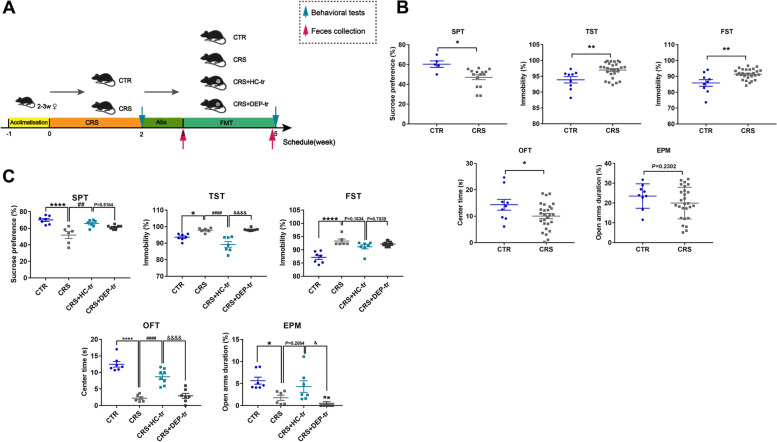Fig. 4.
FMT from healthy volunteers ameliorated depression-like behaviors in mice. A Schematic illustration of the CRS and FMT procedures, with the respective groups labeled above the timeline. In brief, mice were randomly assigned to the CTR and CRS group after 1 week of acclimatization. The CRS modeling lasted for 2 weeks and was followed by the first behavioral tests (indicated by a blue arrow). Next, the mice in the FMT group (suffixed with -tr) were administered ABX, followed by feces collection (indicated by a red arrow) in order to verify the consumption of the native GM in the recipient mice. During FMT period (2 weeks), the mice in the CTR group were treated with 200 μL sterile PBS, while the CRS mice were further divided into 3 subgroups (CRS, CRS + HC-tr, and CRS + DEP-tr), with the CRS + HC-tr and CRS + DEP-tr mice receiving 200 μL of the feces microbiota suspension from the HC and DEP adolescents, respectively. At the end of the FMT, all mice were examined during the second round of behavioral tests (indicated by a blue arrow). B The first round of behavioral tests with measures including sucrose consumption (%) in the SPT, immobility (%) in the TST and FST, center duration (s) in the OFT, and open arms duration (%) in the EPM test. C The second round of behavioral tests in the four subgroups mice. Data were displayed as mean ± SEM. Significant differences were determined via Student’s t test or one-way ANOVA and Tukey’s multiple comparison procedure. *p < 0.05, **p < 0.01, ****p < 0.0001 vs. the CTR group; ##p < 0.01, ####p < 0.0001 vs. the CRS group; &p < 0.05, &&&&p < 0.0001 vs. the CRS + HC-tr group

